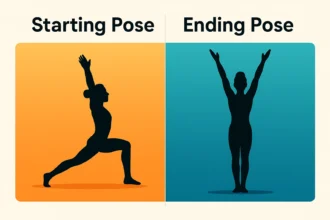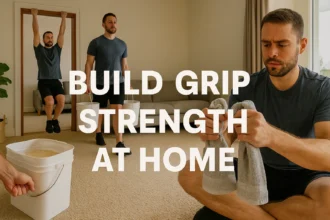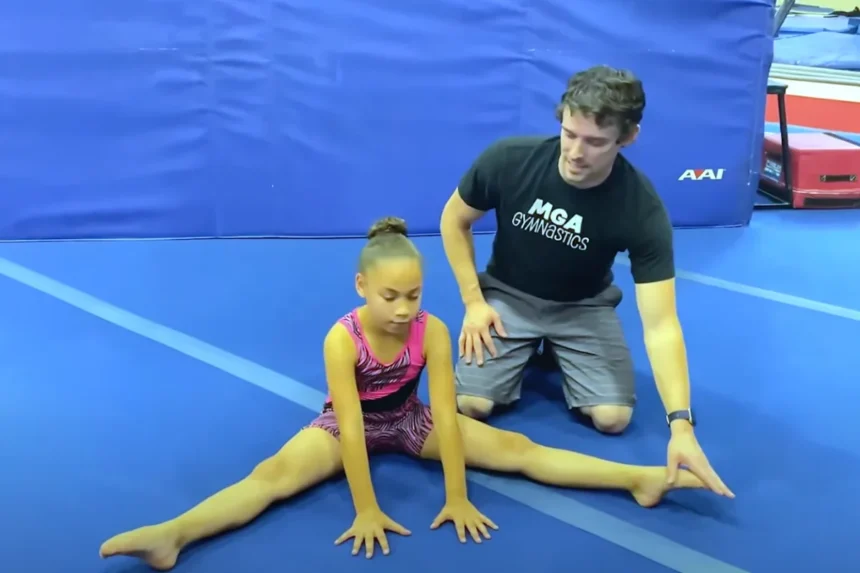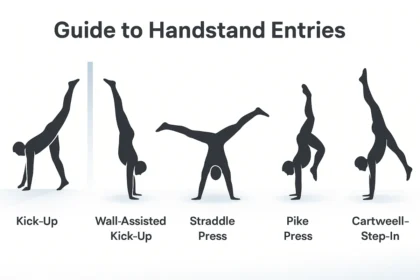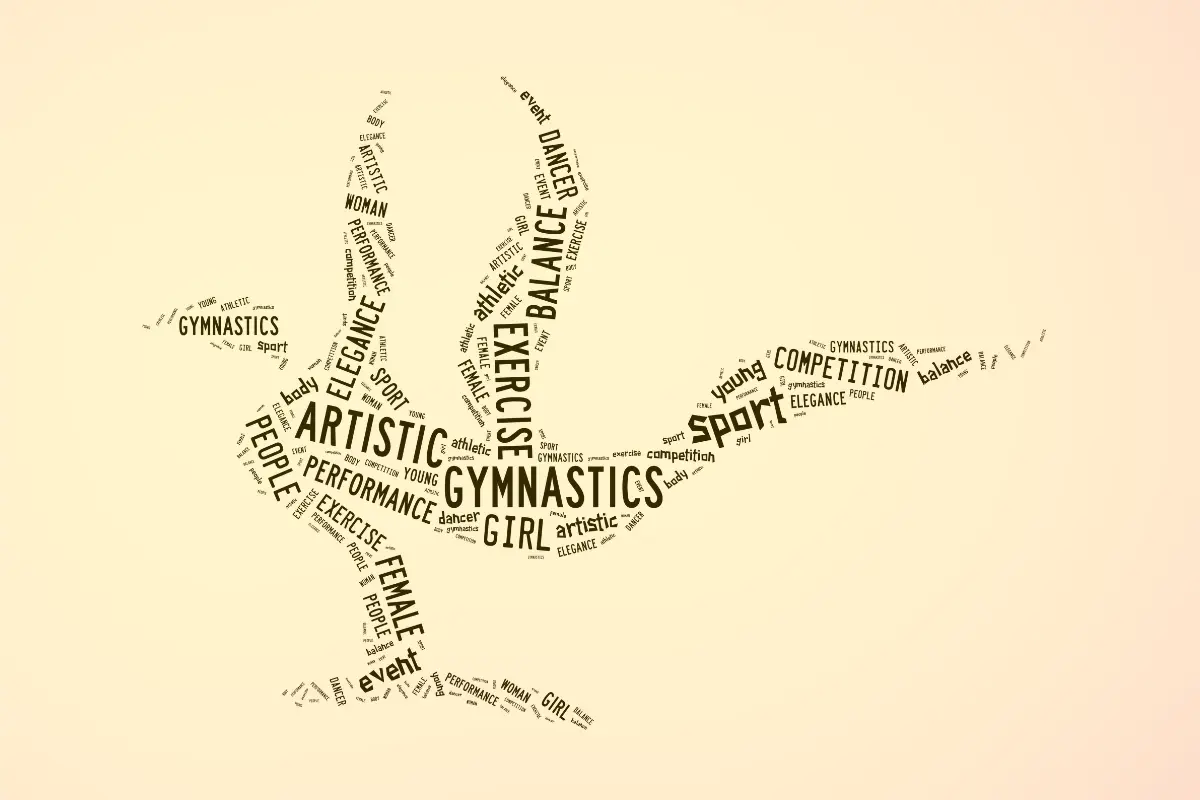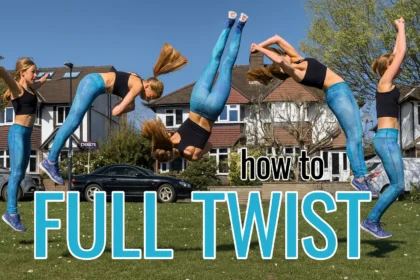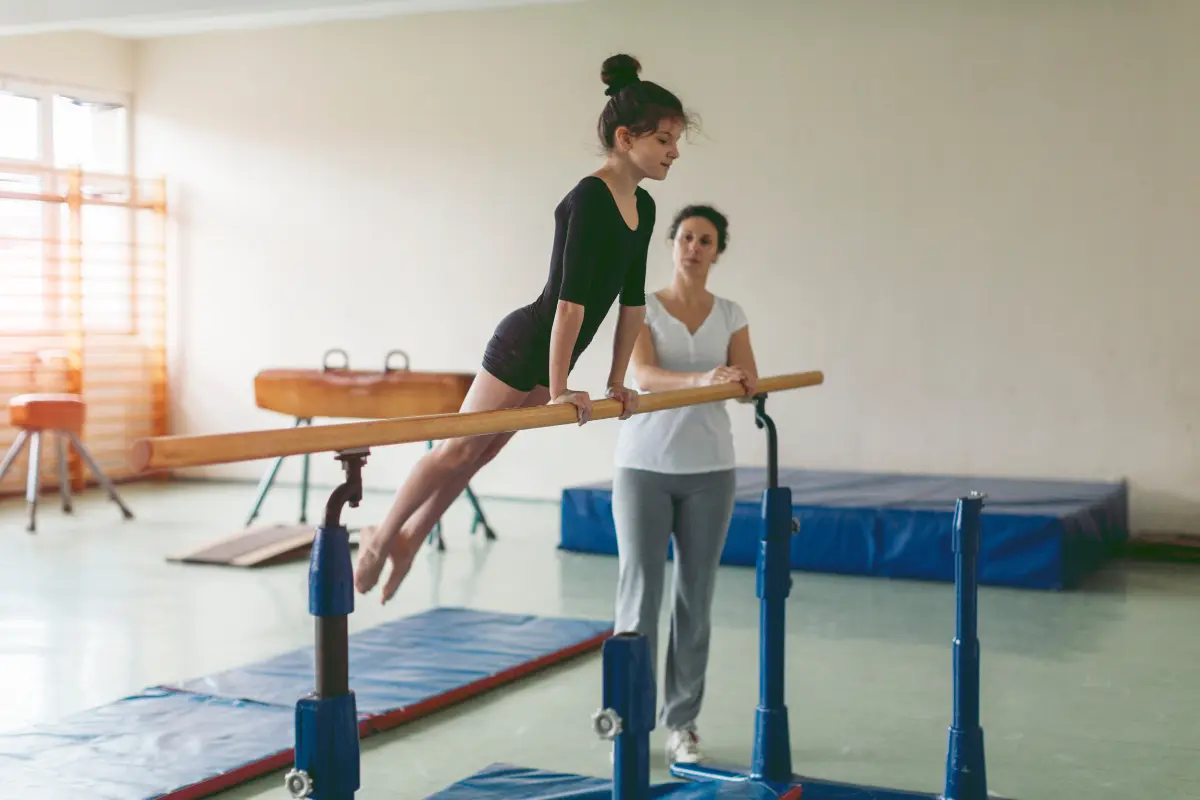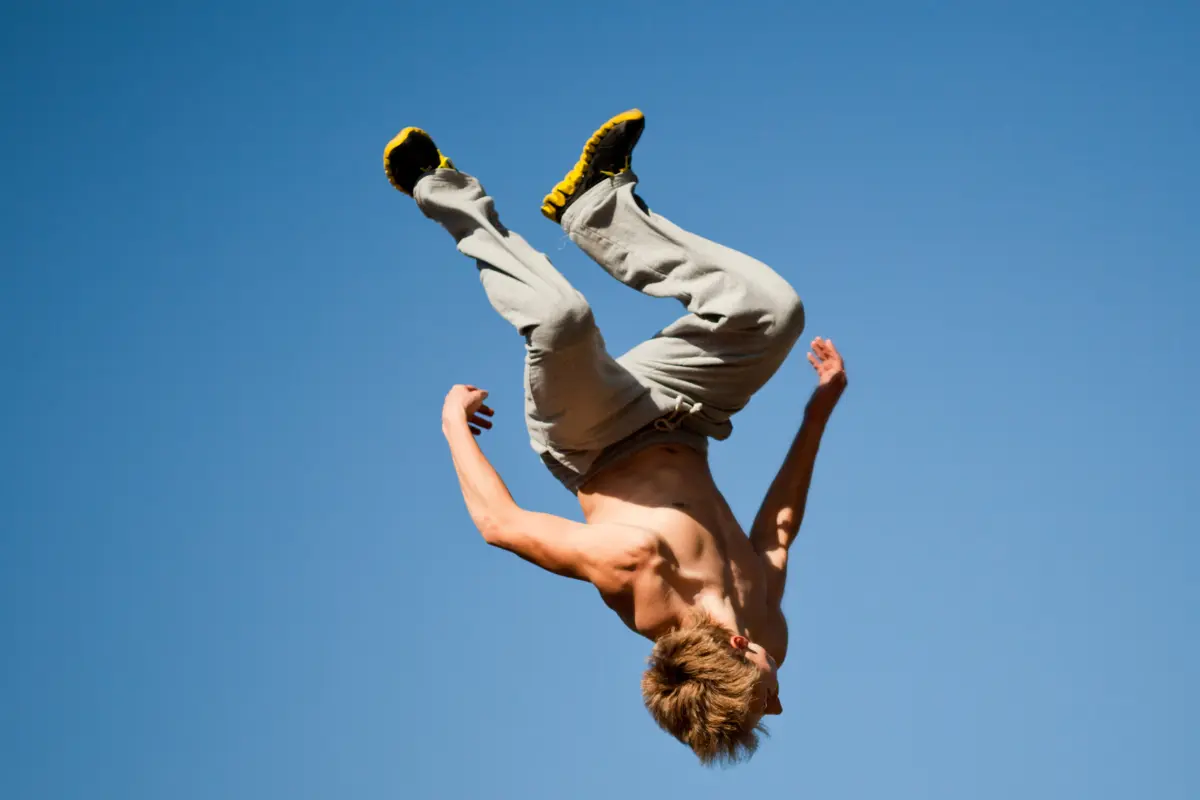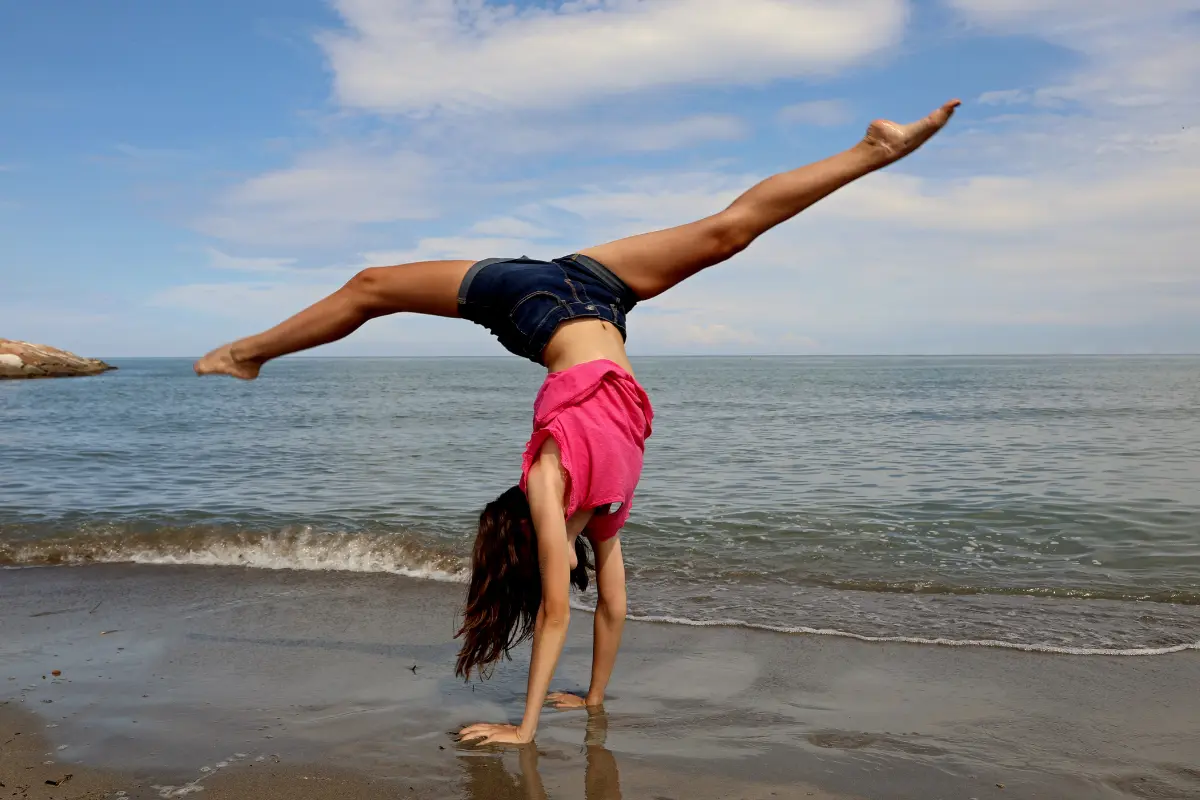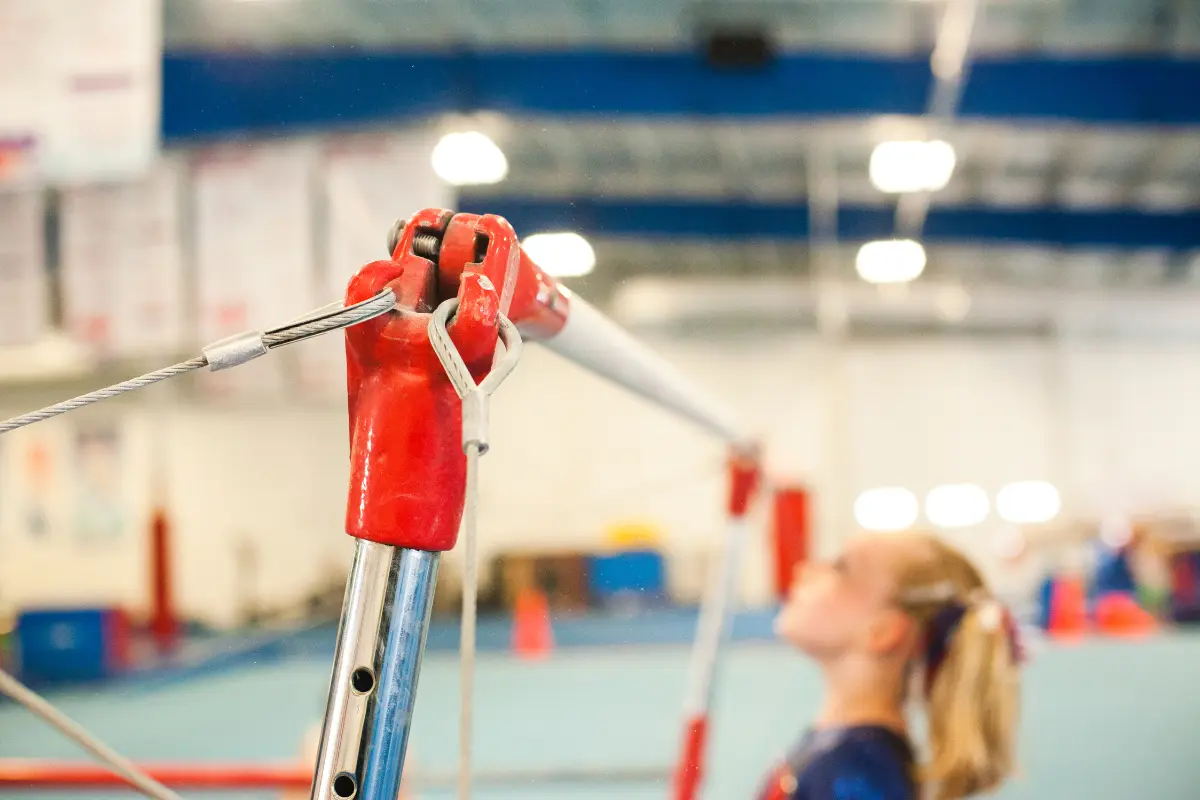In gymnastics, the straddle is a fundamental body position where a gymnast spreads their legs wide apart in a “V” shape.
The straddle shape is one of the basic yet versatile positions in gymnastics, often forming the foundation for both simple and complex skills.
There are three primary variations:
- Seated Straddle: Performed on the floor, commonly used in stretching and warm-ups.
- Aerial Straddle: Seen during jumps and flight elements like straddle jumps or L-sits.
- Inverted Straddle: Performed upside-down in handstands, bar swings, or ring holds.
Key Straddle Movements in Gymnastics
Let’s look at the most common straddle movements and what they’re used for.
1. Straddle Sit
This is when a gymnast sits on the floor with their legs out in a wide “V” shape. It stretches the legs and hips and is often used in warm-ups or before harder skills.
Where it’s used: Stretching, floor basics, flexibility training.
2. Straddle Jump
The gymnast jumps into the air and spreads their legs into a straddle at the highest point. Judges look for good height and straight legs.
Where it’s used: Floor routines and balance beam.
3. Straddle Hold
While sitting or on blocks, the gymnast lifts their legs into a straddle and holds them off the ground using arm and core strength.
Where it’s used: Strength training, floor conditioning.
4. Straddle Back
This move is used on bars. The gymnast swings or flips from the high bar to the low bar with their legs in a straddle shape.
Where it’s used: Uneven bars (mostly in advanced routines).
5. Straddle Roll
A simple roll forward or backward while keeping the legs in a straddle. Great for learning how to move with control.
Where it’s used: Floor routines, beginner classes, strength drills.
6. Straddle Press to Handstand
The gymnast starts in a straddle (either standing or sitting) and lifts into a handstand using only strength—no jump. It’s hard and takes lots of control.
Where it’s used: Floor and beam routines, handstand training.
7. Straddle Planche
This is a very hard skill. The gymnast lifts their whole body off the ground in a straight line, with legs in a straddle. It takes strong arms, shoulders, and core.
Where it’s used: Advanced training, floor strength work.
8. Straddle Split Jump
The gymnast jumps into a straddle in the air and may shift into a split before landing. It shows both flexibility and control.
Where it’s used: Dance sections in floor and beam routines.
Straddle vs. Side Split: What’s the Difference?
Although both involve spreading the legs wide, the straddle and side split (or middle split) differ significantly in alignment and technique.
What is a Straddle?
A straddle is a seated or supported position where the legs are extended out to the sides in a wide “V” shape. The torso remains upright or folds forward, and most importantly—the knees and toes point upward. This means the thighs stay externally rotated, and the pelvis stays neutral (not tilted forward or back).
You’ll see the straddle position often in gymnastics (straddle jumps, straddle presses), calisthenics (straddle holds), and in flexibility work like the pancake stretch.
What is a Side Split (Middle Split)?
The side split—also called the middle split—looks similar at first: the legs move out to each side. However, in a true side split, the torso is aligned with the floor, and the knees and toes face forward, not up. This means the pelvis is tilted forward, and the thighs are internally rotated to lie flat along the ground.
Side splits are commonly seen in martial arts, dance, and flexibility displays where the goal is to completely lower the hips and torso between the legs.
Key Differences at a Glance
| Feature | Straddle | Side Split (Middle Split) |
|---|---|---|
| Leg Direction | Out to the sides, knees/toes facing upward | Out to the sides, knees/toes facing forward |
| Pelvis Position | Neutral or slightly tilted | Tilted forward (anterior tilt) |
| Torso Orientation | Upright or folded forward | Torso aligned with floor |
| Muscles Used | Adductors, glutes, external rotators | Adductors, hamstrings, hip flexors |
| Gravity Role | Minimal; requires active lift/control | Gravity assists stretch depth |
💡 “A middle split is basically a straddle, but the whole shape is rotated 90° forward.”
— u/dani-winks, r/flexibility
Straddle vs. Front Split: Another Key Distinction
Unlike the symmetrical straddle, the front split is an asymmetrical position where one leg moves forward and the other backward.
What is a Front Split?
The front split involves one leg extended forward and the other extended backward, with the torso facing directly ahead. It mimics a forward lunge but goes much deeper. The hips must stay square (facing forward), and the pelvis naturally rotates as the stretch deepens.
The front split is often seen in:
- Split leaps on floor and beam
- Dance and martial arts kicks
- Lunge-based stretching
- Warm-up routines focused on hip mobility
Key Differences at a Glance
| Feature | Straddle | Front Split |
|---|---|---|
| Leg Direction | Both legs out to the sides | One leg forward, one leg back |
| Pelvis | Neutral or slightly tilted | Rotated and squared to front |
| Symmetry | Symmetrical position | Asymmetrical position |
| Muscles Used | Inner thighs, glutes, hamstrings | Hamstring (front), hip flexors (back) |
| Use in Gymnastics | Jumps, presses, static holds | Leaps, transitions, choreography |
Quick Summary
- Straddle = seated or lying side‑to‑side split, pelvis neutral, thighs up (seated) or forward (lying).
- Middle split = flat straddle pancake, pelvis tilted forward, gravity assists widening.
- Front split = one forward leg and one back leg, pelvis shifted, focuses stretch differently.
How Judges Look at the Straddle Position
In gymnastics, the straddle might seem like a basic move—but judges pay close attention to how it’s done.
1. Split Angle (Leg Separation)
Your legs should open wide—usually at least 135 degrees. If they don’t go far enough apart, you’ll lose points. If the split is really small, the skill might not count at all.
2. Straight Legs and Pointed Toes
Bending your knees or having flexed feet (instead of pointed) makes the shape look messy. Judges take off points for each of these small errors.
3. Torso Position (Chest and Back)
In jumps or presses, your upper body should stay upright and strong. If you lean too far forward, arch your back, or lose control, it shows poor form—and judges will deduct for that too.
4. Height and Power (Amplitude)
In jumps, the hips should rise as high as the feet—or higher. If the jump looks low or flat, it’s a sign of weak power or poor technique, and it will lose points.
5. Holding the Shape
Judges want to see you keep the straddle shape all the way through the skill. If you hit the position and then lose it right away—like bending your knees or dropping your legs—you’ll be marked down for inconsistency.
In Summary
The straddle is more than just a split—it’s a foundational position that supports progress in flexibility, strength, and balance. From Level 1 floor routines to elite bar releases, a clean, controlled straddle can make the difference between a solid score and a deduction-heavy routine.



